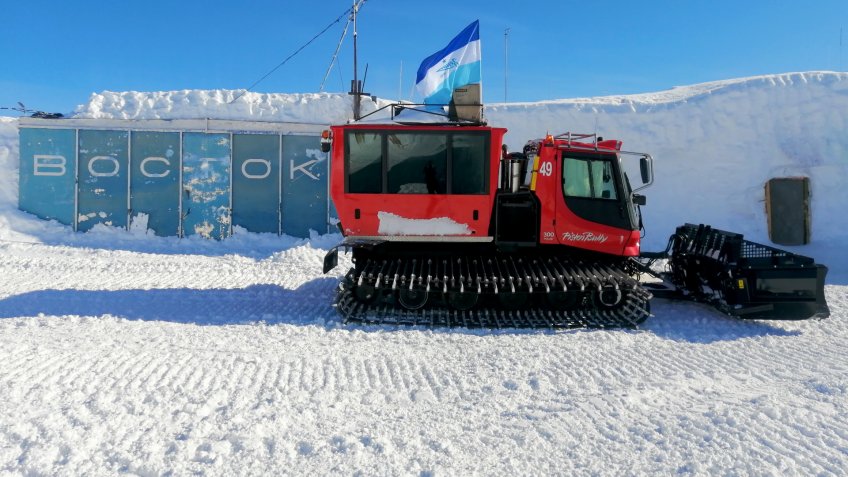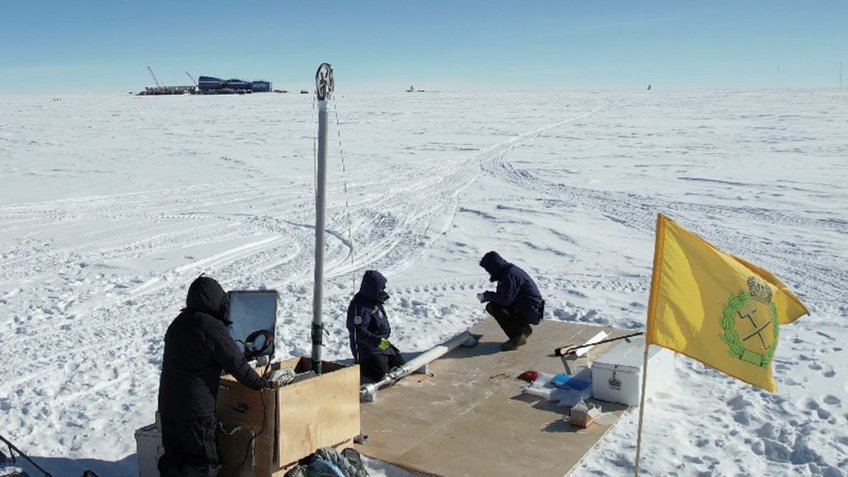
The temperature at research station Vostok in Antarctica is now lower than at the North Pole, although the southern hemisphere is known to be in the height of summer. The bitter cold, wind and snowstorms are becoming the toughest test for scientists at St. Petersburg Mining University and the AARI. Nevertheless, they intend to perform all initially planned experiments. Including getting snow and firn cores from the upper horizons of the glacier, which covers almost the entire continent and reaches a height of about three and a half kilometers above sea level in the area of the East.
"From the extracted snow and firn cores, a reconstruction of the climate over the last 2,000 years is made. This is necessary in order to understand what changes have occurred in the Earth's atmosphere during this time and what consequences they have led to. On the basis of this data it is possible to make predictions for the future. A new shallow borehole VK-23 was drilled ten days ago. At the moment the bottom-hole is at the depth of 22.5 meters. The borehole is half a meter deep with core recovery for further study by glaciologists from AARI", - Alexey Bolshunov, head of scientific party of St.Petersburg Mining University, explained.
In the process of studying samples of snow and firn deposits scientists of the Arctic and Antarctic Research Institute measure the electrical conductivity of the core and identify markers of absolute age: layers containing products of major volcanic eruptions. For example, the Peruvian Winaputina, which in 1600 threw so much ash into the atmosphere that it caused the so-called Little Ice Age, which caused the great famine in Russia and several other countries. Further studies allow us to build a detailed consolidated profile of the density of the snow-firn thickness from the surface to the depth of the borehole, to measure the isotopic composition and to improve the methodology of paleoclimatic reconstructions.
"Antarctica is a treasure trove of invaluable climate information. From core samples from the depths of the glacier, we obtain data on climate change hundreds of thousands of years before our era. At the same time, studies of the top layers of snow are crucial for understanding the most recent climatic changes. They allow us to speak with great accuracy about the transformations that have occurred over the past centuries," says AARI Director Alexander Makarov.
Institute experts, for example, found that for two thousand years until the early 19th century, there was a slight cooling and decrease in the rate of snow accumulation in the eastern region. But over the past 200 years, the situation has changed - both the rate of snow accumulation and temperature have increased. The rate of change at Vostok weather station was 1.6 degrees per hundred years.
"When comparing with paleodata of ice cores, it cannot be claimed that the modern temperature is outside of natural variability. At the same time, the average rate of snow accumulation in the last half century was the highest in 2200 years," specified Alexander Makarov.
As for the air temperature "here and now", two weeks ago, when the polar explorers arrived in the East, during the day it held at minus 30°-32° C. But now it dropped to -40° C, which, of course, complicated the drilling of the shallow well VK-23. The control panel began to freeze, and now it has to be taken to the station's warm rooms for defrosting on a regular basis.
"Temperatures will drop even more in February; last year we left the East at minus 45°-50° C. It is not a pleasant feeling: after a minute in the open air our eyelashes stick together, our beard is covered with icicles from the hot air we exhale, it sticks to our clothes. Metal also behaves differently, it loses its strength. My experience on oil and gas wells shows that at -45°С the work on the rig is temporarily stopped, due to the high risk of derrick, drilling and auxiliary equipment breakdown. The same is true for any equipment. That is why, as it was planned, we have to leave Vostok in the end of the first decade of February, though, of course, all of us would like to prolong a little the season in order to continue our exploration. We will return to the coastal Progress station by sledge-caterpillar trek, which, unfortunately, takes a very long time - 10-14 days versus a three-day trip by Burlak cross-country vehicle", - shared his impressions Vyacheslav Kadochnikov, a leading engineer of the Mining University.
Drilling of the deep well 5G-5 (its fifth borehole) is carried out indoors, that is, in somewhat more comfortable conditions. But the task facing the scientists is incredibly difficult - to get ice cores from the horizons, which Western specialists have never reached, their record is 2800 meters. Russian polar explorers extracted the first core this season from a depth of 3437 meters. Its length was 160 centimeters. It is less than the cylinders, which were hoisted last year, but there is a very logical explanation. The penetration has fallen due to the changes in the temperature regime of the glacier and the peculiarities of ancient ice crystals formation at such great depths.
"At the moment, the bottomhole is at a depth of more than 3,490 meters. The last core recovered so far is 140 centimeters long. With every tenth meter, it becomes harder to drill, the penetration decreases, and the filters get clogged. It's a tough job, but in the process of drilling a deep ice hole we are gaining unique experience, which is the groundwork for further improvement of profile technologies and development of even more efficient equipment and tools. Today we have several patents for new drilling tools," said Danil Serbin, Lead Engineer at Mining University.
If we go back to the shallow well, it is necessary not only for obtaining snow and ice cores, but also for sampling ice sludge, which occurs during drilling of the upper horizons. The fact is that if it is not removed from the bottomhole in time, it can have a very negative impact on the operation of equipment. Therefore, one of the most urgent applied problems faced by scientists is to increase the efficiency of the cuttings transportation process.
This problem is being solved by Dmitry Vasiliev, a postgraduate student at St. Petersburg Mining University, who, together with his colleagues, is conducting research related to the use of compressed air as a cleaning agent. A special stand for this research was developed by scientists at the Mining University and made in its educational and experimental workshops. It goes without saying that all experiments take place strictly in the spare time from the main work at the drilling complex.
"At the moment, we are studying samples of ice sludge taken from well VK-23. Using a set of laboratory sieves, we conduct its particle size analysis, as well as determine the equivalent diameter and volume of ice particles using microscopic photographs. In parallel, for ice sludge from various horizons we determine the velocity of the upward flow, i.e. the speed of the upward flow in which the particle occupies a balanced position, without rising up and descending at the same time. This characteristic is fundamental when designing drilling systems with air," said Dmitry Vasiliev.
He also clarified that this season polar explorers are conducting experiments to study the process of capturing ice sludge with new cyclone filters. Now in drilling rigs, including KEMS-132, which is used for deep drilling at Vostok station, mesh filters are used for this purpose. However, they have a number of serious drawbacks. Scientists at the Mining University have developed a new concept based on the principle of cyclonic air purification. According to the results of research work conducted this season, it is planned to justify its implementation in the technological process of drilling the snow-firn thickness of the glacier.
Another innovation is being "brought to its fruition" by Vyacheslav Shadrin, a graduate student at the Mining University. He is at the final stage of assembling the experimental stand for researching the process of ice breaking by the reciprocating method, which is based on the dynamically balanced drilling tool (DUBS), developed by Professor Edward Zagrivny, a professor of the oldest technical university in Russia.
"At the moment, the bearing structure of the stand is assembled, its power supply system is installed and integrated into the 5G-5 drilling complex, and the algorithm-program code is written. Experiments will start one day, and my colleagues are helping me in their free time after 8-hour shifts. Danil Serbin and Vyacheslav Kadochnikov designed and manufactured a sawtooth-type drill bit, and Alexei Bolshunov and Sergey Ignatyev designed a brush-type drill bit. During the experiments we will test the efficiency of the reciprocating ice breaking, as well as examine different types of rock destruction tools, which so far have not been used in the field," explained Vyacheslav Shadrin.
All these developments will be in demand in the future, during the next, already the third penetration to the subglacial Lake Vostok. It is located at a depth of more than 3700 meters below the station and for a long time was isolated from the Earth's atmosphere. Scientists from the Mining University and AARI penetrated it twice, in 2012 and 2015, and took unique samples of relict water. In both cases, as predicted, the water rose into the well, several hundred meters up, and then froze.
In order for Russian scientists to repeat their own achievement and surpass it, for example, to obtain samples of lake bottom sediments or data on the influence of deep phenomena occurring in the depths of Antarctica on the planet's magnetosphere, a new drilling complex must be built (the current one is already obsolete, both morally and physically). All the innovations the polar explorers are working on now will become its technological basis.





